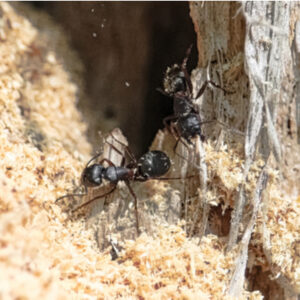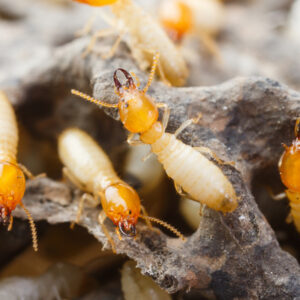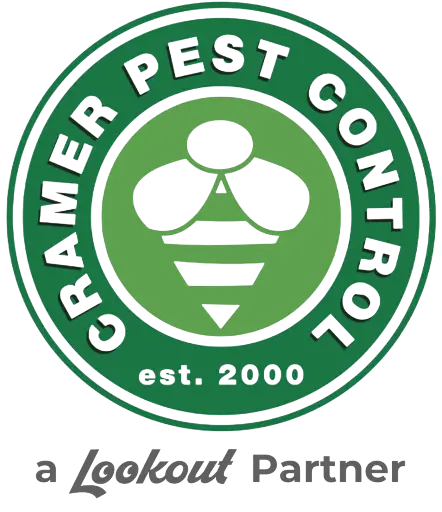We all know how annoying pests can be once they find their way into our homes. They cause structural damage, get into our food, and can be difficult to remove. Most pests are pretty manageable, but some are downright terrible. Here are the five worst pests to find in your home and what to do if you spot them.
Powderpost Beetles
The first on our list is an elusive pest that spends most of its time out of our sight. Powderpost beetles are wood-boring pests that cause problems for homeowners every year. These small, cylindrical beetles get their name from the powdery dust their larvae leave behind as they emerge from their woody nursery. New and current infestations are indicated by soft, white, powdery residue, called frass, around small holes in your wood. Older, inactive infestations are indicated by yellow, caked powder.
Here in North and South Carolina, there are two types of powderpost beetles to be aware of: anobiid and lyctid powderpost beetles. Anobiid powderpost beetles are known for attacking softwood, like pine, spruce, and fir while lyctid powderpost beetles attack hardwood, like oak, ash, and maple. Between the two types, powderpost beetles can cause damage to wood throughout your home.
Powderpost Beetles Cause Damage to:
- Floor Joists
- Wall Studs
- Wood Framing
- Antique Furniture
- Wood Floors
- Trim and Interior Moldings
The good news is that these destructive pests are pretty easy to control once you identify them. Powderpost beetles love damp wood and areas with high moisture and humidity. You can prevent powderpost beetle infestations by ensuring your home has excellent ventilation throughout the attic, basement, and crawlspace.
Carpenter Ants

A colony of carpenter ants is one of the most destructive pests found in our homes. Though they don’t eat wood, like termites, they voraciously burrow through the wood as they build and expand their nest. In just a couple of years, you could have a colony of 2000 – 3000 carpenter ants in your home. They typically nest in damp or moist wood, especially in areas that have easy access to the outside.
Common Carpenter Ant Nesting Locations:
- Attic
- Voids in Walls, Under the Floor, and Under Cabinets
- Structural Wood
- Hollow beams
- Window and Door Casings
- Hollow Doors
- Insulation
To put it bluntly: carpenter ants are some of the worst pests to find in your home. The damage they cause to the wood in and around your home can be devastating and may require extensive repairs if you don’t catch them in time. You can prevent carpenter ants from invading your home by ensuring all of your entrances to your home are properly sealed. Check gaps around doors and windows, cracks in the foundation, areas where wires enter your home, loose shingles on the roof, and any hole small enough for an ant to fit. It’s a good idea to keep mulch away from the foundation of your home and trim any trees and shrubs so their branches don’t touch your home.
Fire Ants
Fire ants are the most infamous type of ant found in the United States. These angry pests are known to aggressively defend their nests by swarming, biting, and stinging. The bites and stings are extremely painful and can result in dangerous allergic reactions. Usually, fire ants are found in large mounds outside, but they have been known to nest indoors as well.
Fire ants make their way into your home in search of food. If they find enough, then they can quickly find a place to settle in and make a nest. Typically, these nests can be found in walls or under the floor. You can spot a potential fire ant nest in your home if you find loose soil around expansion joints. If you find a fire ant nest in your home, then it’s important to act fast to avoid painful and dangerous stings.
The best fire ant control is prevention. If you have fire ants inside, then that means you have fire ants outside too. Treating your yard for fire ants helps reduce the population around your home and prevents possible infestations in your home. Seal all of your entrances and plug up any cracks or holes around the foundation to make it more difficult for pests to gain entrance. Always make sure to keep your food stored in a secured container to avoid accidentally feeding the colony.
Bed Bugs
One of the worst pests to find in your home is the bed bug. These tiny pests cause huge problems for homeowners everywhere. They’re famously persistent and an infestation of bed bugs can mean months of issues and re-infestations. These little bloodsuckers hide out in our beds, couches, carpets, rugs, and other areas around the home. Bed bugs are incredibly small and difficult to see. Usually, most people don’t know they have an infestation until they start to notice bug bites all over their bodies.
When it comes to bed bug control, vigilance is important. Monitoring your beds, couches, and carpet ensures you’ll be able to act fast if you find bed bug evidence. Watch for bed bug casings and small rust-colored stains. If you do have an infestation, then it’s best to trust the professionals. Bed Bugs can survive without feeding for over a year, so getting them all removed is essential. Bed Bug control from Cramer Pest Control is your best bet.
Termites

Of all the interior pests, termites are by far the worst. Some estimates put termite damage in the United States at over $2 billion every year. These hungry pests eat through the wood in and around your home as their colony grows. Here in North and South Carolina, the most destructive termite infesting homes is the Formosan subterranean termite.
Termite control is best left to the professionals, but it’s important to monitor your home so you can find an infestation before it gets out of control. Watch for mud tubes that creep up your foundation and into your home. Termites use these tunnels to travel around. You can also check for termite damage by checking for hollow sounding wood or wood that feels soft. Remember, a termite colony can have as many as 2 million workers, so getting them early is essential.
Cramer Pest Control Can Help Protect Your Home From These Terrible Pests
Here at Cramer Pest Control, we know the headaches that can be caused by pests. If you have an active infestation or are looking to protect yourself from the worst pests, then it’s time to invest in pest control. At Cramer Pest Control, we have pest control programs to fit every situation. So, whether you’re looking for Residential Pest Control, Indoor Pest Control, Bed Bug Control, or Termite Control, the experts at Cramer Pest Control have the solution for you.
Don’t wait for the problem to get out of control, call us now at (704) 763-0204 or (803) 802-7540 to get started. You can also contact us here for more information. Don’t forget to follow us on Facebook for the latest deals and check out our blog for monthly pest control tips and tricks.
5 Worst Pests to Find in Your Home in North Carolina and South Carolina
Protecting North Carolina and South Carolina
